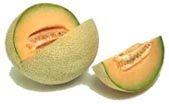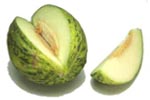Cookbook:Melon
| Melon | |
|---|---|
| Category | Fruits |
Cookbook | Recipes | Ingredients | Equipment | Techniques | Cookbook Disambiguation Pages | Ingredients | Fruit
Many melons originated in the Middle East and gradually spread its popularity across Europe. Ancient Egyptians and Romans enjoyed cantaloupes or muskmelons. Melon seeds were transported to the United States by Columbus and eventually cultivated by Spanish explorers in California.
Melons are in the same gourd family as squashes and cucumbers. Most melons have similar structure to winter squash with thick flesh and inner seed-filled midsection. So what’s the difference between melons and squashes? It’s the way that they’re used. Squashes are considered vegetables, while melons are known as fruits with sweet and juicy flavor.
Melons are a good source of vitamin C and potassium. They have high water content are relatively low in Calories, and also fat and cholesterol free.
Varieties
[edit | edit source]There are many melon varieties. Cantaloupe, honeydew, and watermelon are the most well known varieties.
 | Cantaloupe — Also called a muskmelon, this familiar fruit with orange flesh and khaki netted colored skin provides the most beta-carotene in the entire melon family. Select melons that are slightly golden with a light fragrant smell (an indication of its ripeness). Cantaloupe is typically available year-round, with a June through August peak season. |
| Casaba — Unlike the other melons, casaba melons do not have an aroma. This is a large melon that is pale yellow when ripe and has white flesh with a sweet taste. This melon peaks in the fall, but starts showing up in markets in July through December. | |
 | Crenshaw — These melons can weigh up to ten pounds and deliver a unique sweet and spicy flavor. They are a hybrid between the casaba and Persian melon with a yellowish skin and salmon-colored flesh. Peak season for Crenshaw melons is August through September, with the fruit season beginning in July and ending in October. |
 | Honeydew — The sweetest of all the melons and averaging five to six pounds, honeydew melons have a creamy yellow rind when ripe and pale green flesh. It’s best from June through October, but is available year round. |
 | Persian — This melon is quite similar to the Cantaloupe, but it slightly larger in size, has a greener rind, and on the outside it has finer netting. Persian melons peak in August and September with the season beginning in June and ending November. |
 | Santa Claus — This melon is also known as the Christmas melon because it peaks during the month of December. This variety is similar to the watermelon with the green and gold stripes, but is about a foot long and isn’t as sweet as the other melons. |
 | Sharlyn — This melon tastes like a cantaloupe and honeydew combined. Sharlyn melons are sweet with netted outer layer, greenish-orange rind, and white flesh. The availability varies, so check your local supermarkets and farmer’s market. |
Selection
[edit | edit source]In general, melons should be shaped according to their variety. For example, cantaloupes should be round, etc. In addition, melons should not have cracks, soft spots, or dark bruises. You should look for a clean and smooth break at the stem and for most mature melons have a fruity fragrance (if not chilled).
Storage
[edit | edit source]Keep uncut melons at room temperature for two to four days or until fully ripe, then refrigerate for up to 5 days. Refrigerate cut up melon in a covered container up to 3 days. Remember that cut melons are aromatic and their smell will penetrate other foods.
Preparation
[edit | edit source]Always wash melons in warm soapy water before cutting to get rid of any impurity on the rind that might be carried from the knife blade to the flesh. Simply cut the melon in half and scoop out the seeds and strings. Melons can be cut into halves, quarters, wedges, cubes, or scooped into balls with a melon baller. Most melons will benefit from a squeeze of lemon or lime juice to enhance the flavor. Serve at room temperature.
